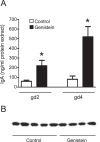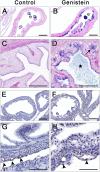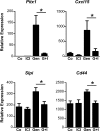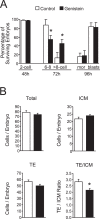Neonatal phytoestrogen exposure alters oviduct mucosal immune response to pregnancy and affects preimplantation embryo development in the mouse
- PMID: 22553218
- PMCID: PMC3406554
- DOI: 10.1095/biolreprod.112.099846
Neonatal phytoestrogen exposure alters oviduct mucosal immune response to pregnancy and affects preimplantation embryo development in the mouse
Abstract
Treatment of neonatal mice with the phytoestrogen genistein (50 mg/kg/day) results in complete female infertility caused in part by preimplantation embryo loss in the oviduct between Days 2 and 3 of pregnancy. We previously demonstrated that oviducts of genistein-treated mice are "posteriorized" as compared to control mouse oviducts because they express numerous genes normally restricted to posterior regions of the female reproductive tract (FRT), the cervix and vagina. We report here that neonatal genistein treatment resulted in substantial changes in oviduct expression of genes important for the FRT mucosal immune response, including immunoglobulins, antimicrobials, and chemokines. Some of the altered immune response genes were chronically altered beginning at the time of neonatal genistein treatment, indicating that these alterations were a result of the posteriorization phenotype. Other alterations in oviduct gene expression were observed only in early pregnancy, immediately after the FRT was exposed to inflammatory or antigenic stimuli from ovulation and mating. The oviduct changes affected development of the surviving embryos by increasing the rate of cleavage and decreasing the trophectoderm-to-inner cell mass cell ratio at the blastocyst stage. We conclude that both altered immune responses to pregnancy and deficits in oviduct support for preimplantation embryo development in the neonatal genistein model are likely to contribute to infertility phenotype.
Figures






References
-
- Jefferson WN, Padilla-Banks E, Newbold RR. Adverse effects on female development and reproduction in CD-1 mice following neonatal exposure to the phytoestrogen genistein at environmentally relevant doses. Biol Reprod 2005; 73: 798 806 - PubMed
-
- Wira CR, Grant-Tschudy KS, Crane-Godreau MA. Epithelial cells in the female reproductive tract: a central role as sentinels of immune protection. Am J Reprod Immunol 2005; 53: 65 76 - PubMed
-
- Fichorova RN, Cronin AO, Lien E, Anderson DJ, Ingalls RR. Response to Neisseria gonorrhoeae by cervicovaginal epithelial cells occurs in the absence of toll-like receptor 4-mediated signaling. J Immunol 2002; 168: 2424 2432 - PubMed
Publication types
MeSH terms
Substances
Grants and funding
LinkOut - more resources
Full Text Sources
Molecular Biology Databases

